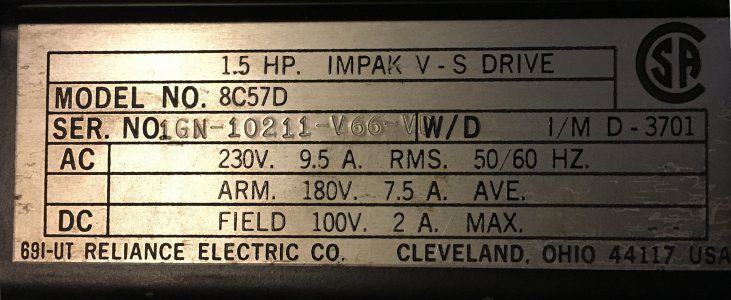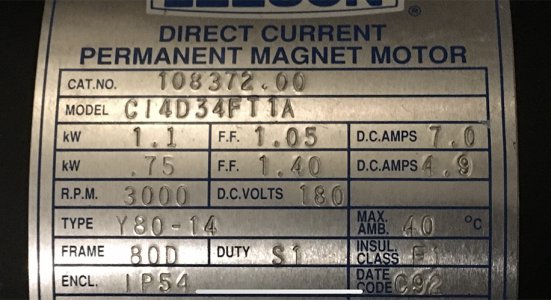- Joined
- Jan 11, 2013
- Messages
- 1,820
Hello Everybody
If any of this is already described elsewhere, I would appreciate links to any message threads, or websites that describe what I'm confused about, if it has already been covered.
A little while ago I purchased a number of DC motors and DC drives from a guy who had been "collecting" them to (but had barely began to) match them together. Any that he could repair, he would if he could.
One was already "matched", but now I want to begin to test, and then match as many remaining working motors to remaining working controllers. Many of the motors and controllers I end up not matching together, that won't suit my machines, I may be selling off or finding homes for.
I don't want to burn anything up for a stupid reason like connecting inappropriate motors/drives together. After extensive Googling, (possibly using incorrect terms?) I am having a hard time making sure which numbers need to match, or which numbers need to be "less than", or if the motor specs should be much "less than", and when.
SO:
-I would like to learn how to match appropriate motor specs to drive specs
-I would like to know the importance of DC motor "armature voltage" vs "field voltage" (unless I REALLY don't need to know)
-I would like to know how far below the Driver-voltage can the motor be, or does the motor-voltage need to be higher than the driver-voltage? Or does it need to be exact?
-Is just wiring up possibly-correct motors and drivers together and powering them on a reasonable way to check them? or should I put the Fluke Meters and look for certain readings on motor leads or driver connections first, somehow?
-What do I do when the DC-Driver has no specs, or limited specs? It has been VERY hard to find vintage PDF's of brochures, manuals, catalogs to glean this information, even for Bodine, who is still in business (I called them!). Maybe I should try calling them again?
-I heard that the TYPE of DC motor might effect driver choice, as regards matching a drive to either a Permanent-Magnet, Series, Shunt, or Compound motor.. Is this true?
I can post pics of more motor spec-plates and driver spec-plates (if there they have one)
-All of the motors in question are permanent magnet DC motors, Porter Peerless, Dayton, and one really nice Leeson (**this is one of the first I want to match up, it's new**)
-I have a few different Reliance IMPAK "V-S" drives- one non-"V-S", a nice Bodine drive, and a Dayton drive.
For instance..
.
One of the IMPAK drive's plate says:
1.5 HP
AC 230v 9.5 A. RMS. 50/60 HZ.
ARM 180v 7.5 A. AVE.
DC FIELD 100V. 2A. MAX
.
A Leeson Motor plate says:
1.1kW (1.5 HP) F.F. 1.05 D.C. AMPS 7.0
.75kW (1.1 HP) F.F. 1.40 D.C. AMPS 4.9
RPM: 3000 D.C. Volts: 180
(This is a nice motor, but is "metric" or something, and does not give NEMA, but IEC numbers)
Do these go together?
I attached pics of these plates to this post.
... So the most powerful DC motor attached to this should be above or below 100V?
I am assuming the motor should be less than 2A at that voltage.
Thank you for reading! This was the SHORT version of this post!
Bernie
If any of this is already described elsewhere, I would appreciate links to any message threads, or websites that describe what I'm confused about, if it has already been covered.
A little while ago I purchased a number of DC motors and DC drives from a guy who had been "collecting" them to (but had barely began to) match them together. Any that he could repair, he would if he could.
One was already "matched", but now I want to begin to test, and then match as many remaining working motors to remaining working controllers. Many of the motors and controllers I end up not matching together, that won't suit my machines, I may be selling off or finding homes for.
I don't want to burn anything up for a stupid reason like connecting inappropriate motors/drives together. After extensive Googling, (possibly using incorrect terms?) I am having a hard time making sure which numbers need to match, or which numbers need to be "less than", or if the motor specs should be much "less than", and when.
SO:
-I would like to learn how to match appropriate motor specs to drive specs
-I would like to know the importance of DC motor "armature voltage" vs "field voltage" (unless I REALLY don't need to know)
-I would like to know how far below the Driver-voltage can the motor be, or does the motor-voltage need to be higher than the driver-voltage? Or does it need to be exact?
-Is just wiring up possibly-correct motors and drivers together and powering them on a reasonable way to check them? or should I put the Fluke Meters and look for certain readings on motor leads or driver connections first, somehow?
-What do I do when the DC-Driver has no specs, or limited specs? It has been VERY hard to find vintage PDF's of brochures, manuals, catalogs to glean this information, even for Bodine, who is still in business (I called them!). Maybe I should try calling them again?
-I heard that the TYPE of DC motor might effect driver choice, as regards matching a drive to either a Permanent-Magnet, Series, Shunt, or Compound motor.. Is this true?
I can post pics of more motor spec-plates and driver spec-plates (if there they have one)
-All of the motors in question are permanent magnet DC motors, Porter Peerless, Dayton, and one really nice Leeson (**this is one of the first I want to match up, it's new**)
-I have a few different Reliance IMPAK "V-S" drives- one non-"V-S", a nice Bodine drive, and a Dayton drive.
For instance..
.
One of the IMPAK drive's plate says:
1.5 HP
AC 230v 9.5 A. RMS. 50/60 HZ.
ARM 180v 7.5 A. AVE.
DC FIELD 100V. 2A. MAX
.
A Leeson Motor plate says:
1.1kW (1.5 HP) F.F. 1.05 D.C. AMPS 7.0
.75kW (1.1 HP) F.F. 1.40 D.C. AMPS 4.9
RPM: 3000 D.C. Volts: 180
(This is a nice motor, but is "metric" or something, and does not give NEMA, but IEC numbers)
Do these go together?
I attached pics of these plates to this post.
... So the most powerful DC motor attached to this should be above or below 100V?
I am assuming the motor should be less than 2A at that voltage.
Thank you for reading! This was the SHORT version of this post!
Bernie



